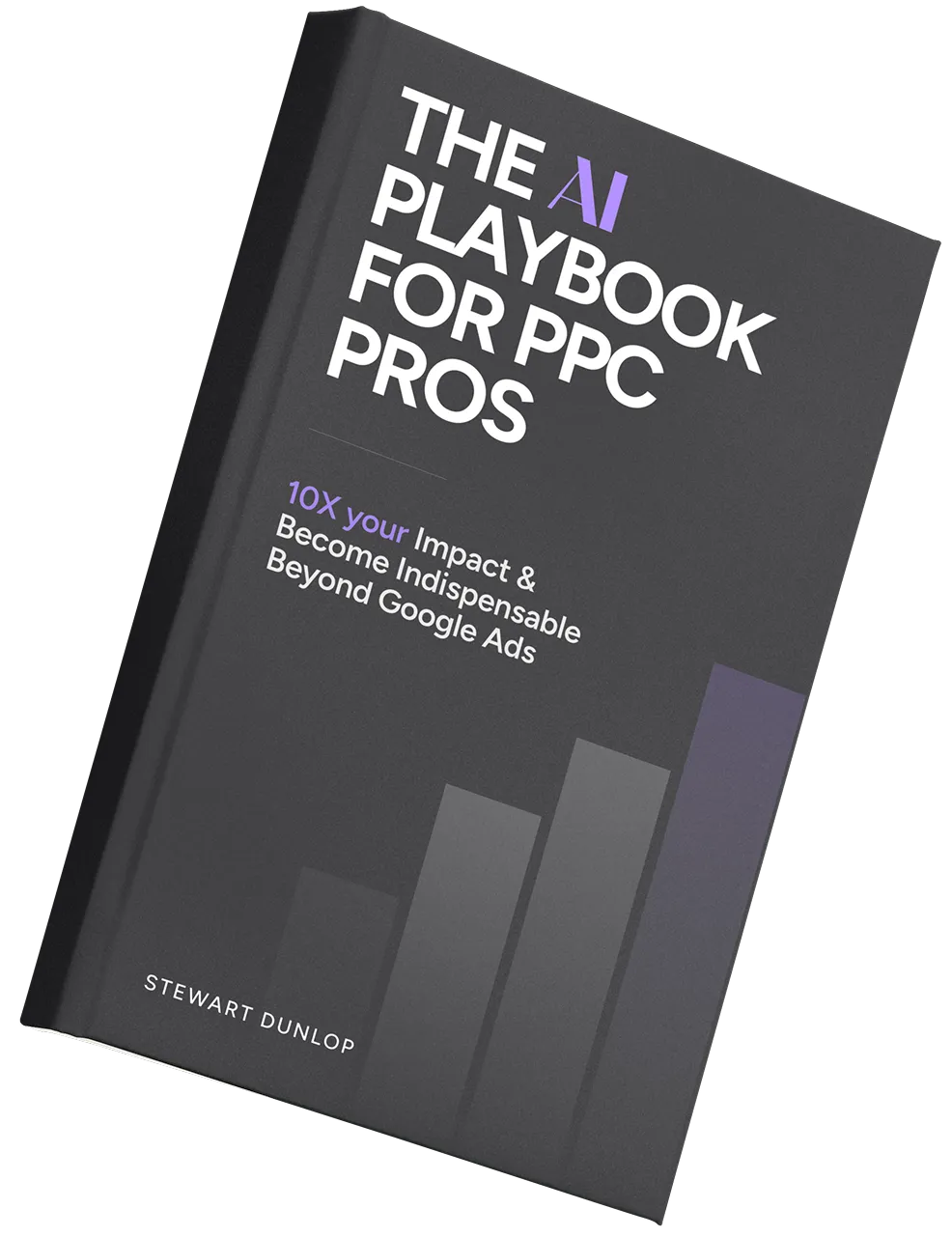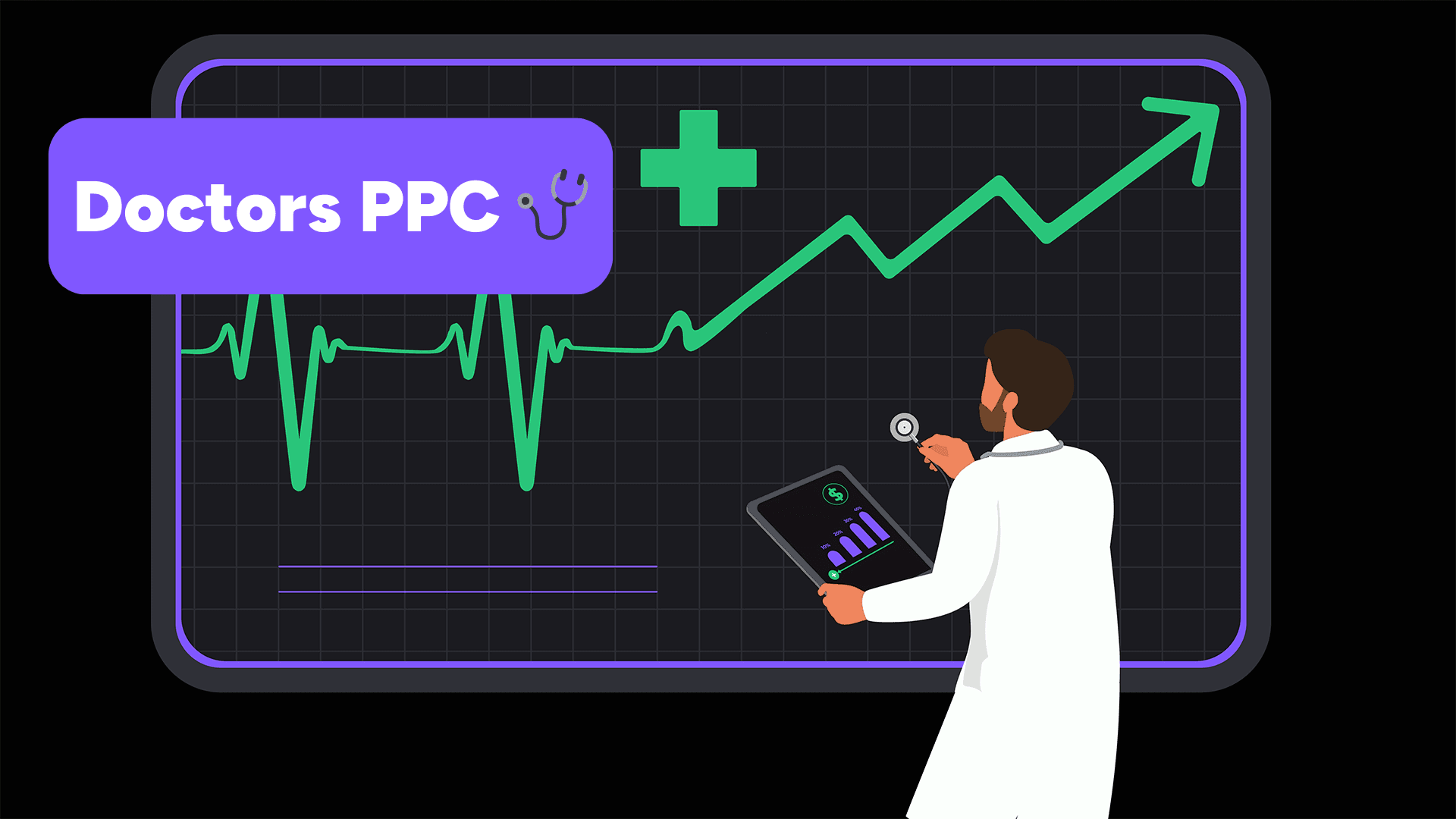
Summary
- Pay-per-click advertising is a type of online advertising that healthcare professionals can use to get more leads and increase patient numbers.
- For local practices, geotargeting is essential. Doctors should ensure their ads are shown to users in their geographic area to increase the relevance and effectiveness of their ads.
- Ensure that all ads comply with healthcare advertising regulations and guidelines, which include patient privacy laws and truthful representation of services.
- Stay clear of retargeting strategies to prevent HIPAA violations.
- Steps to follow to get your medical PPC campaigns right include developing a strategy, creating your Google Ads account, and conducting keyword research.
77% of U.S. patients research their symptoms online before booking an appointment. This means a strong online presence is essential for healthcare practices.
The country has over 230,000 physician practices. If you run a medical practice, you're likely competing with other healthcare providers in your area. You may be asking yourself:
➡️ How do I attract new patients?
➡️ What is the best way to promote our services?
Pay-per-click (PPC) advertising may be an effective solution because it allows medical professionals to secure a spot on the first page of a search engine like Google.
The numbers speak for themselves—28% of people end up visiting the website of the practice or hospital advertised in a paid ad.
PPC advertising can be a great way to:
✔️Secure more patient appointments
✔️Promote telehealth services
✔️Grow your medical practice
✔️And more
In this article, we'll explain the benefits of PPC for doctors and provide insights on how to start effectively from day one.
What Is PPC for Doctors?
PPC (pay-per-click) is a digital advertising strategy that enables medical professionals to promote their services online.
By using PPC, doctors can place ads on search engines like Google.
When potential patients search for healthcare services or medical advice related to the doctor's field of specialty, these PPC ads can appear in the search results.
For example, if you search “primary care physician Austin,” you’ll see that the top three search results are PPC ads for medical services.
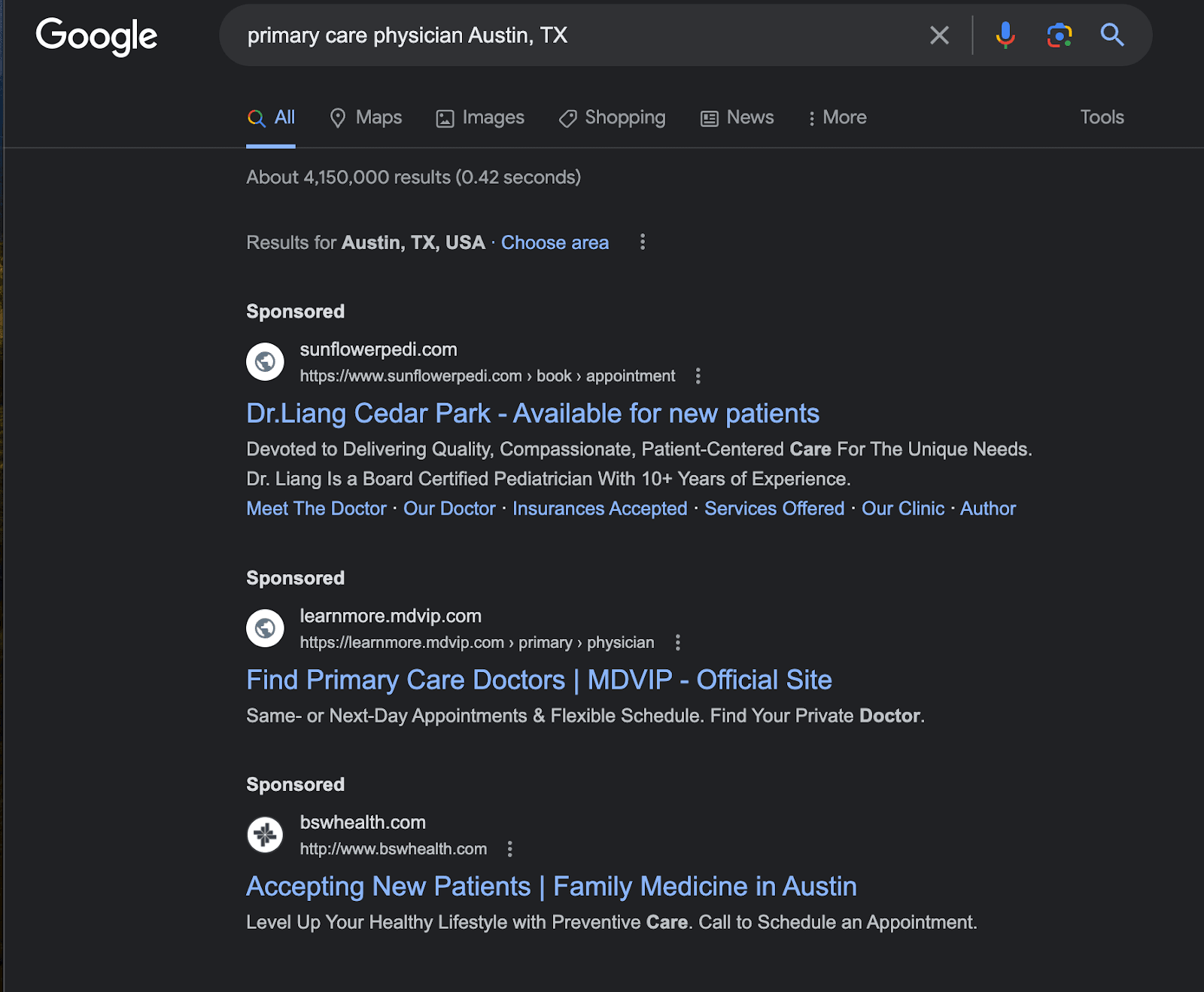
When someone clicks on one of these sponsored links, the company is charged a fee. If there's no click, then there's no charge.
This type of advertising is beneficial for doctors because it targets individuals who are actively seeking medical services, potentially leading to higher engagement and conversion rates.
PPC advertising can be an effective way for doctors to:
👉 Attract new patients
👉 Increase online visibility
👉 Promote specific treatments or services they offer
👉 Increase their local presence
Additional benefits of PPC include:
💰 Cost-effective advertising
💻 Driving online bookings
📊 Measuring and analyzing performance
How Does PPC Advertising Work?
To understand how PPC works, you first need to understand keywords—these are the terms people type in when they search online.
The search engine uses keywords to understand what the user is looking for and decide what websites to show them.
It also helps search engines decide which sponsored ads to show.
“doctor near me” is a typical example of a keyword someone might type into Google.
In the medical field, common keywords might include:
🔎 Primary care physician Dallas
🔎 Best pediatricians in New York
🔎 Urgent care
🔎 Affordable dermatologists
🔎 How to find a reputable clinic
🔎 Cost of medical checkup
These keywords guide search engines in presenting relevant websites and sponsored ads to users, making them crucial in targeting the right audience for a medical practice or healthcare service.
Set a budget and bid on keywords
Medical practices can allocate a specific budget for their ads and decide how much they're willing to pay for each click with their PPC (pay-per-click) advertising campaigns.
For example, if someone searches "pediatrician in Chicago," an auction determines which ads are displayed.
This auction evaluates:
- The amount you bid.
- The ad’s relevance to the searched keyword.
- The overall quality of the ad.
- The relevance and quality of the website linked in the ad.
Ads that score well on these criteria get top placement in search results, while those with lower scores may not appear at all.
Each click on an ad costs the medical practice a portion of its PPC budget.
Even when they’re not the highest bidder, this setup allows practices to effectively compete in the auction by focusing on the relevance and quality of their ads and landing pages.
What determines the price of a bid?
For physicians using PPC ads, the price you pay for each click depends on the keywords you choose.
Keywords with high commercial intent—which implies that a person is ready to engage in a service—are usually in higher demand and are more expensive.
For instance, a keyword like “primary care physician near me” has a cost per click (CPC) of $2.50.
Since it shows that someone is looking for a medical professional right now, a keyword like this will typically be expensive, as a lot of medical practices would like to have their ad appear for it and are willing to bid higher.
It’s also a high-traffic term, with more than 47,000 global monthly searches.
We got these figures from the SEO tool Ahrefs—you can see them in the screenshot below. They might differ slightly on other platforms.

“best female primary care doctors near me,” on the other hand, has a CPC of just $1.30.

Even though it also has high buyer intent, the term attracts only about 1,000 global searches per month and the lower traffic likely contributes to its cost per click being less expensive.
How Does PPC Advertising Work in the Medical Industry?
💡 Guidelines for advertising healthcare on Google
In Google’s advertising policy, it states:
“We are dedicated to following advertising regulations for healthcare and medicine, so we expect that ads and destinations follow appropriate laws and industry standards.
Some healthcare-related content can’t be advertised at all, while others can only be advertised if the advertiser is certified with Google and targets only approved countries. Check local regulations for the areas you want to target.”
ⓘ See here for Google’s advertising policy for healthcare and medicines.
Now that you know a bit more about how PPC works, let's take a closer look at the unique challenges that come with advertising medical services.
When you're running a medical practice, it's important to be aware that Google scrutinizes your ads and landing pages to ensure they comply with their policies.
Google has specific guidelines for advertising healthcare services to ensure responsible and accurate advertising. The key guidelines include:
Restricted content
Google allows ads for certain healthcare services and products like prescription and over-the-counter medications, but there are important rules to follow.
First, you'll need to get approval from Google and make sure your ads meet the guidelines for your region.
Not everything can be advertised. For example, Google only allows ads for CBD oil to be shown in California, Colorado, and Puerto Rico.
ⓘ Here is a detailed list provided by Google that outlines which medications and products are off-limits for advertising.
Plus, some ads might have a limited audience. Certain products and services like pharmaceuticals and addiction treatment centers can only be advertised in specific countries, and you'll need special certification from Google for this.
ⓘ You can find more information on these restrictions and how to get certified here.
Misleading claims
To avoid unrealistic claims about medical products or services, Google's guidelines for healthcare advertising require that all ads be truthful.
This means steering clear of suggesting guaranteed results or all-encompassing cures.
The landing pages linked to these ads must be reliable, offering clear and factual information about the advertised service or product.
For instance, when featuring patient testimonials or before-and-after photos, it’s important to include phrases like “Results vary and are not guaranteed,” which sets realistic expectations.
Landing pages must be accurate
Like most industries advertising on Google, it's crucial that the content on the landing page accurately reflects the ad's message.
For example, if an ad promotes cognitive behavioral therapy (CBT), the corresponding landing page should specifically provide information about CBT.
Google’s sophisticated algorithms can quickly detect any inconsistencies. If this is the case, your ads will be seen as irrelevant and won’t be shown in search queries.
No retargeting
Google prevents healthcare marketers from using retargeting ads to reach potential patients.
This means that if someone visits a hospital or practice website or clicks on an ad, they can't be encouraged back with display ads on other sites.
Tracking personal health information could violate laws like HIPAA which states that you can’t use personal health information without explicit consent.
Imagine someone searches online for information about diabetes treatment and visits several hospital websites.
After this, they browse the Internet. They begin to notice ads from these hospitals regarding diabetes care services.
This specific situation is what Google's regulations seek to prevent. These rules are in place primarily to protect patient privacy.
They ensure that users' online search behaviors, especially those regarding sensitive health information, do not lead to targeted advertising that could infringe on privacy or exploit their health concerns.
Familiarize yourself with Google’s policy on adult-orientated content
Google's strict ad policies disapprove of nudity and sexually suggestive content.
This presents challenges for doctors specializing in women's health, OB/GYN, and plastic surgery.
These fields often require discussing or showing body parts, which could unintentionally fall under Google's restricted content categories.
ⓘ You can find Google’s policy on “adult-orientated content” here.
🧠 Need help with your medical brand's Google ads?
Navigating ad policies can seem challenging for physicians advertising services that Google classifies as sensitive—but that's where we come in.
At PPC.io, we're Google advertising experts, ready to guide you through these complexities.
Our team specializes in crafting compliant and impactful ads, ensuring your health message is conveyed effectively without the risk of being flagged.
Contact us today for expert assistance in digital healthcare PPC.
How to Get Started with Healthcare PPC Campaigns
Whatever your medical specialty, a well-crafted PPC campaign can put your services in front of the right audience at the right time.
This section will help you set up your ad campaign and show you the steps you need to take when advertising your medical practice.
➡️ Get verified by Google
Before setting up a PPC campaign, we recommend that you apply for the Google Screened Program.
Google Screened is a trust and verification program designed by Google for certain service-oriented businesses, particularly in professional fields like law, financial planning, real estate, and medical services.
While it's not mandatory, this extra layer of trust helps businesses establish credibility for their Google listings and ads among potential clients.
Here's an overview of the Google Screened program for healthcare providers:
Eligibility
To earn the Google Screened badge, businesses undergo a thorough background check, which may include checks on:
➡️Business registration
➡️Professional licenses
➡️Insurance
➡️The practice owner's background.
The extent of the verification process varies based on the business category and location.
Google Screened badge
Once a business passes these checks and meets Google's standards, it receives a Google Screened badge.
Once verified, healthcare providers can participate in Google Local Services Ads.
These ads target local audiences, which is ideal for doctors who often serve patients in specific geographic areas.
Doctors' ads can appear prominently when potential patients search for medical services nearby.
In addition to appearing at the very top of search results, these ads include a Google Guarantee badge, which helps build trust.
For doctors, this is crucial, as trust is a significant factor in a patient's choice of healthcare provider.
Here’s what it looks like:
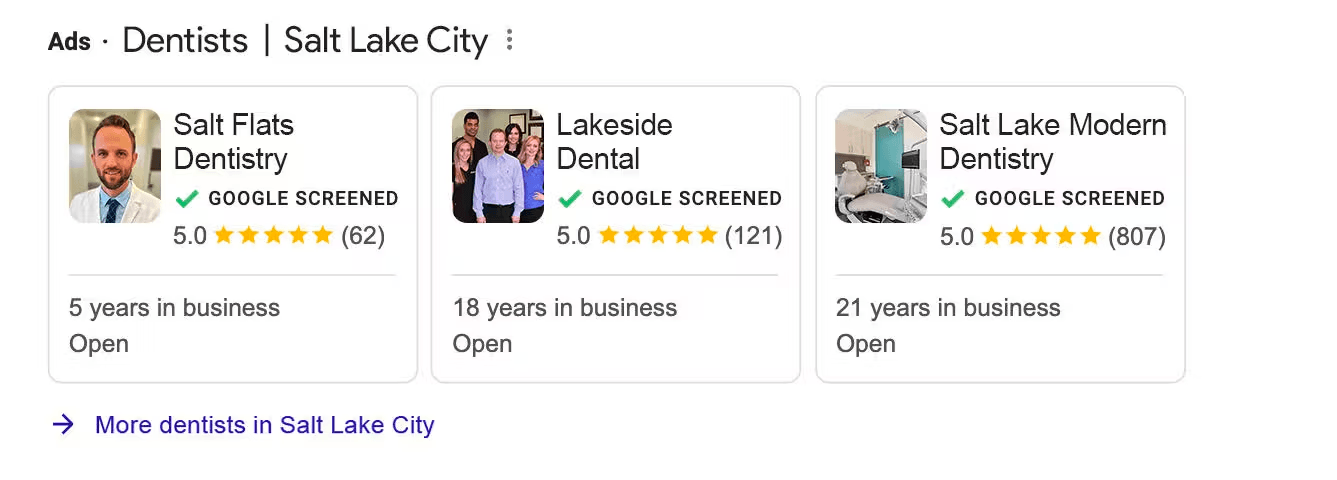
Continuous compliance
Providers must continue to meet Google's standards to maintain their Google Screened status. This includes providing Google with up-to-date licenses and proof of insurance coverage. It also involves maintaining positive patient reviews.
What are the benefits of being Google Screened?
Being Google Screened can significantly benefit healthcare providers in a few ways:
✅ Enhanced credibility: The Google Screened badge signals to potential clients that a professional has passed a background check and has met specific requirements. This badge can significantly boost a professional's credibility.
✅ Increased visibility: Google Screened professionals appear in Local Services ads, which are prominently displayed at the top of Google search results. This heightened visibility can lead to increased exposure and more potential clients.
✅ Quality leads: Since these ads are shown to users specifically searching for related services, the leads generated are often of higher quality. Users already looking for these services are more likely to engage.
✅ Competitive edge: Having the Google Screened badge differentiates professionals from their competitors. It's a mark of trust and reliability that can influence a potential client's decision-making process.
✅ Review and rating display: These profiles prominently feature client reviews and ratings, providing social proof and further establishing the professional's reputation.
➡️ Define your campaign objectives
Setting clear goals is crucial for the success of your medical practice's PPC campaign. Before launching, it's important to establish what you aim to accomplish.
Common objectives for medical practices might include:
- Patient acquisition
- Increasing awareness of your practice
- Highlighting specialized medical services
- Expanding to new geographical areas
- Boosting website traffic
➡️ Pay extra attention to your landing pages
Most PPC campaigns for primary care doctors link to a specialized landing page on their practice's website.
These landing pages should be fine-tuned by:
- Making sure the landing page matches what your patients are looking for. For example, if your ad is about primary care services, the page should focus on those services.
- Quickly establishing trust with these visitors by showcasing the practice’s credibility and expertise through patient testimonials or professional accolades.
- Prompting visitors to take action, such as booking an appointment.
- Providing easy ways for visitors to get in touch with the practice, like contact forms or phone numbers.
- Enhancing the practice's brand recognition by ensuring it remains in the minds of visitors, even if they don't book an appointment immediately.
The quality and relevance of the landing page linked to your PPC campaign are crucial for your ad rank score on platforms like Google Ads.
Before launching a PPC campaign, it’s vital to ensure that your landing page meets these criteria.
For instance, if someone searches for “primary care physician Austin,” here is one of the top results: a medical practice called Baylor, Scott & White Health:

Here is their landing page:
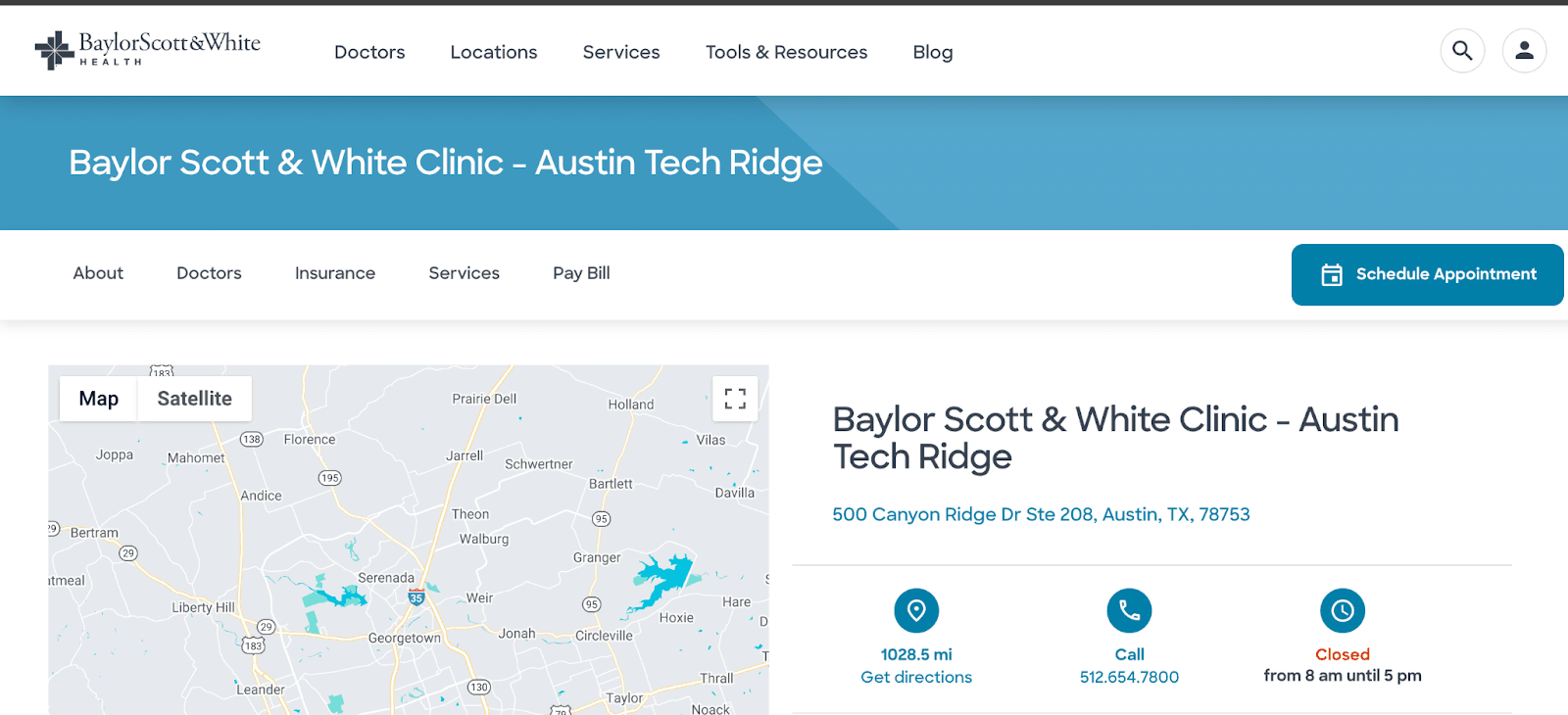
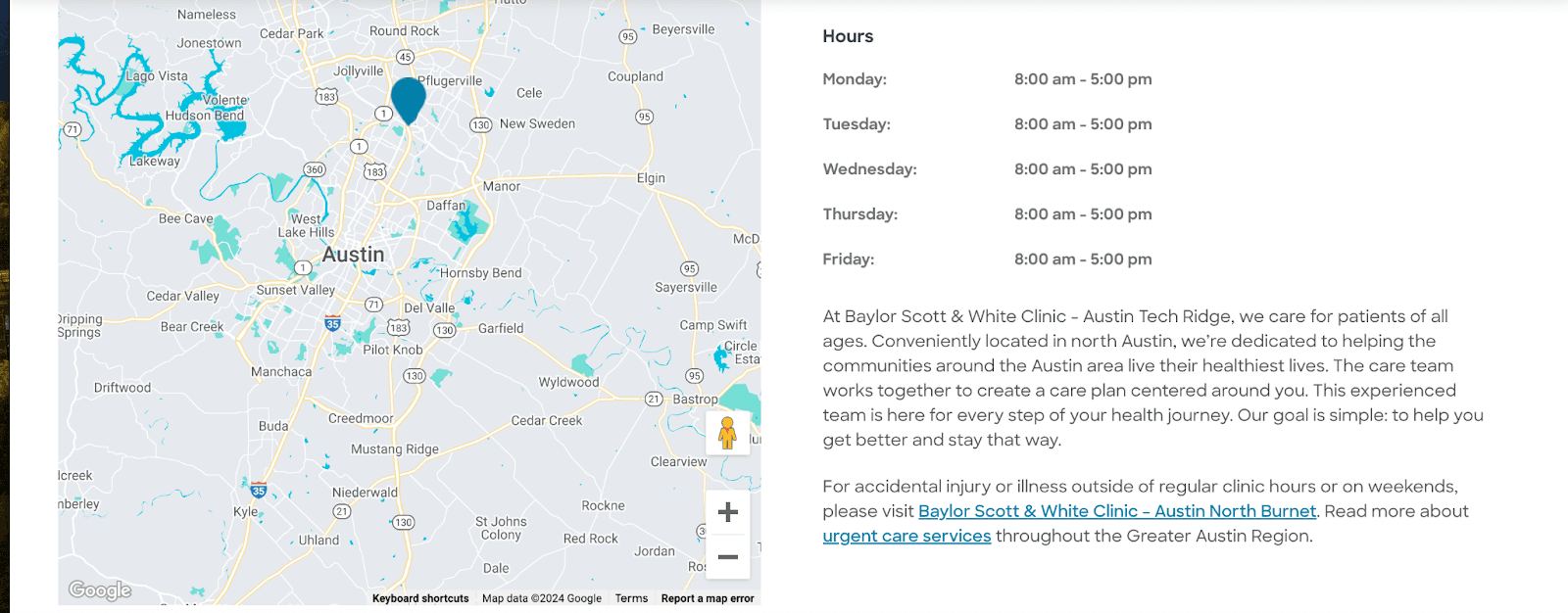
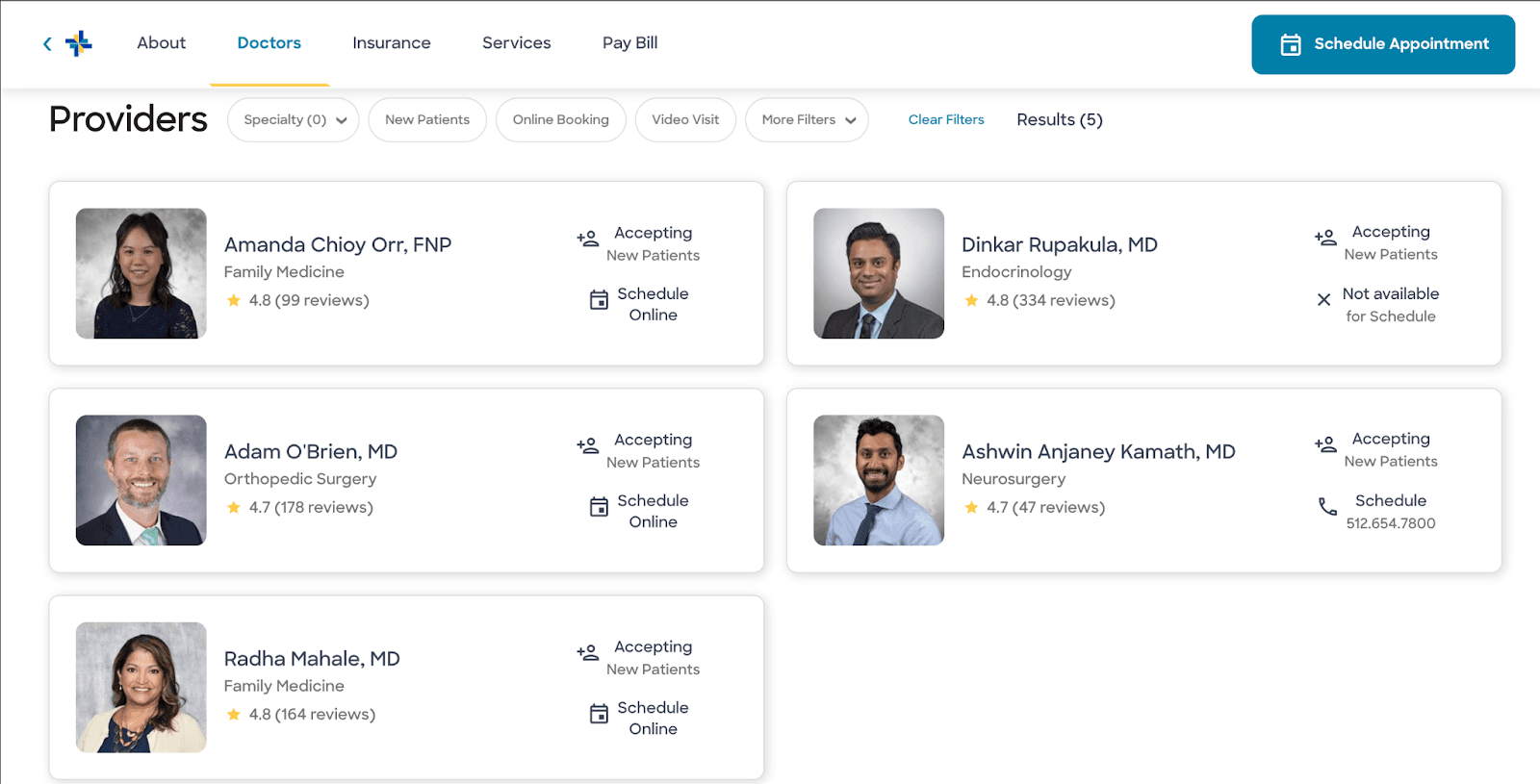
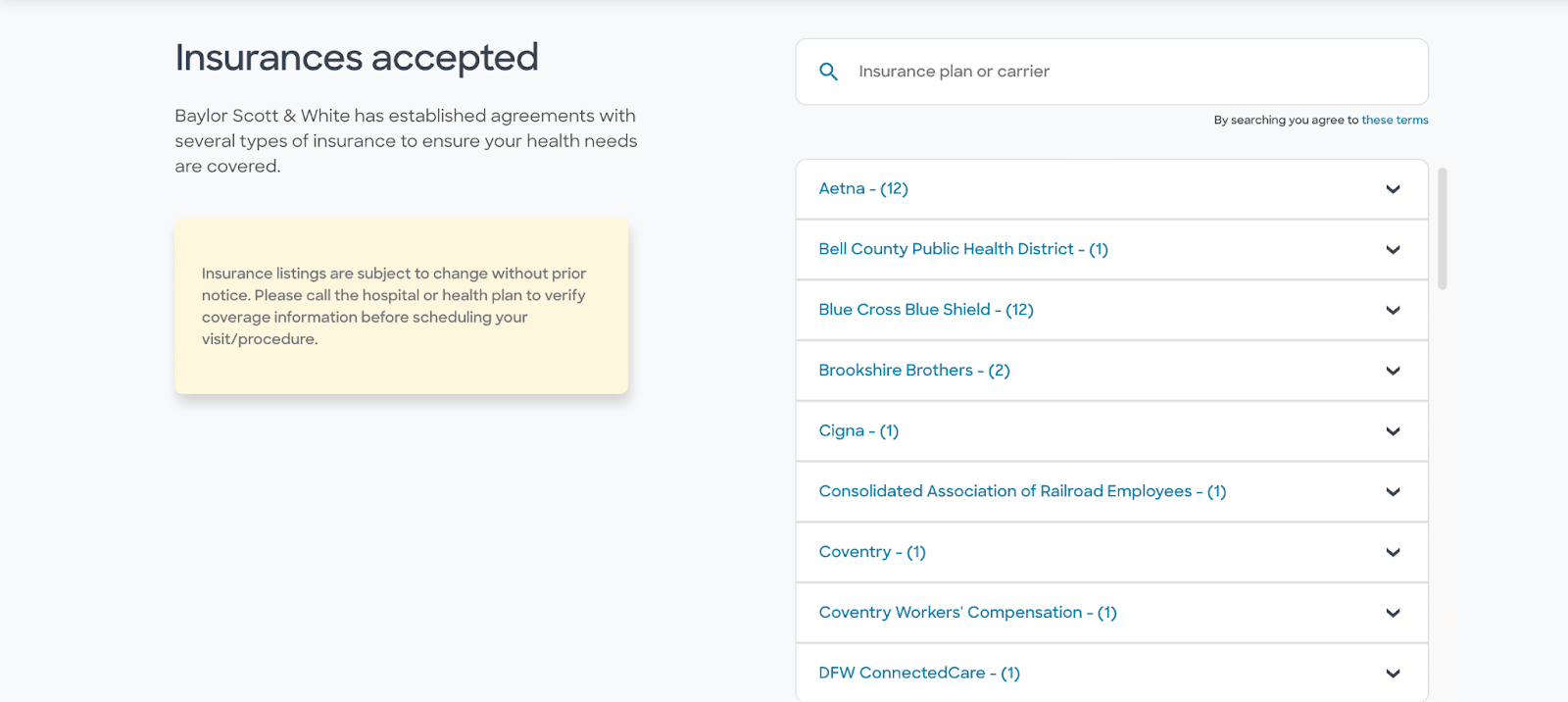
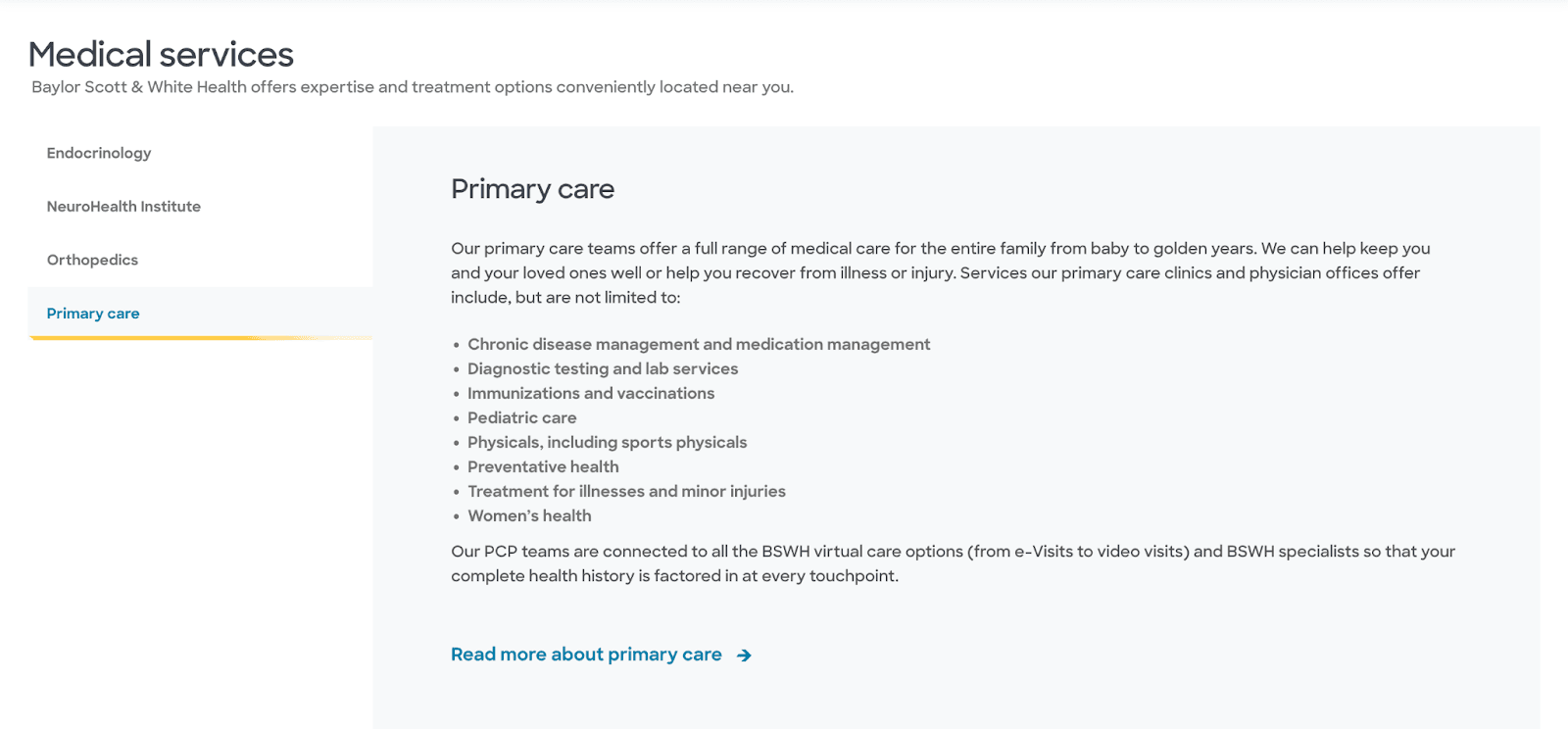
Here’s why this page works:
✔️ Clear CTA: There is a clear and prominent CTA (Book an appointment) which is easy to find and use.
✔️Accurate information: The information about medical services, treatments, and qualifications is accurate and up-to-date. They have also avoided making exaggerated claims about the effectiveness of their treatments or services.
✔️Nice design: The page looks smart and is easy to use.
✔️Strong branding: The logo and brand colors are simple and easy to recognize.
✔️Contact information: This page clearly states the practice’s location, contact information, and hours. This helps to establish the legitimacy of their services.
➡️ Create your Google Ads account
If this is your first PPC campaign, you will need to set up your Google Ads account to get started. The good news is it’s completely free.
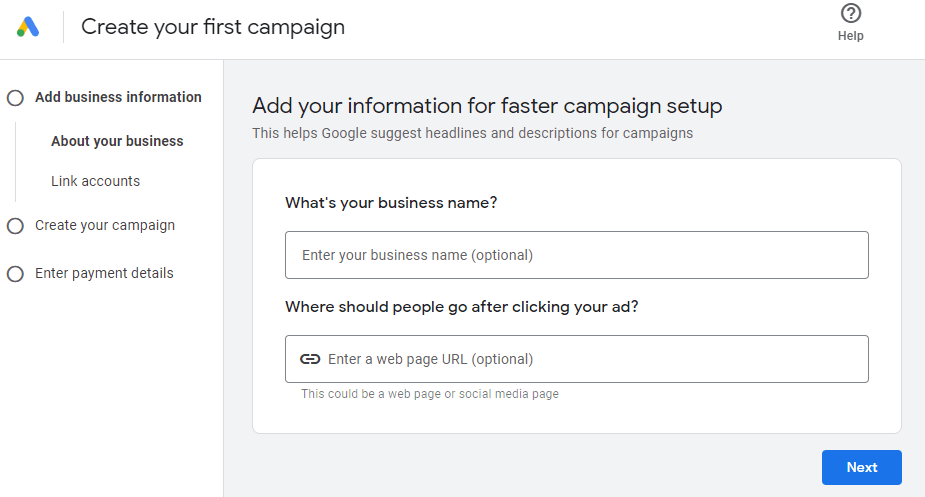
Creating an account only requires a few steps, and then you can get your campaign up and running.
You’ll need to provide:
✅ Information about your business
✅ Details about your campaign goals and budget
✅ Your credit card details
➡️ Choose the right keywords
Now it’s time to give some thought to the words or phrases your ideal patient is likely to type in when they visit Google.
To get this step right, you’ll need to do some keyword research with a tool like Google Keyword Planner, Ahrefs, or SEMRush.

You need to find keywords that:
✅ Are relevant to what your medical practice offers.
✅ Show strong buyer intent.
✅ Are affordable: Cost per click (CPC) measures the estimated amount you’ll pay per click for this term.
✅ Get lots of searches: This is usually called volume or traffic.
✅ Aren’t too competitive: As the name suggests, keyword difficulty in Ahrefs indicates how difficult it is to rank for a keyword organically. Google Ads refers to this as keyword competitiveness.
Keywords with a higher buyer intent tend to be more expensive. This can be seen in our example from earlier, “primary care physician near me.” This keyword indicates that the searcher is looking for medical services right now. Therefore, more people would be bidding on this search phrase.

“Best female primary care doctors near me,” on the other hand, has a CPC of only $1.30 because fewer people search for this term each month.

💬 Narrow down your list of keywords
Once you’ve figured out the types of content your target audience is likely searching for, you can narrow this list down to specific keywords you want to focus on.
For example, say you are a primary care doctor in Denver. Start by brainstorming a comprehensive list of keywords that potential patients might use when searching for primary care services.
Focus on keywords that are most relevant to your target audience and location.
Your list might include:
🔎 Primary care physician
🔎 Family doctor near me
🔎 Walk-in clinic denver
🔎 Primary care clinic
🔎 Affordable primary care
🔎 Primary care physician Denver
🔎 Primary care telemedicine services
💬 Use negative keywords to your advantage
In addition to choosing keywords that you want your ads to show up on, it’s crucial to filter out searches that are unrelated to the services you offer.
This is where negative keywords come into play. They help you avoid wasting your ad budget on irrelevant clicks.
So, as a primary care physician, you might want to avoid people searching for terms like:
❌ Specialized medical fields: Don’t include specialties that your practice doesn’t offer, such as 'dermatologist,' 'cardiologist,' 'orthopedic,' etc.
❌ Medications and drugs: If you don't prescribe or deal with specific medications, include them as negative keywords. For example, 'opioids,' 'sleeping pills,' and 'antidepressants'.
❌ Emergencies: If you don’t offer emergency services, add terms like 'emergency', 'urgent care,' and '24/7 clinic'.
➡️ Utilize ad extensions and add a “Call Us” feature
A call extension is a feature in Google Ads that lets advertisers put their phone numbers in their ads.
When people see the ad, they can click on this phone number to quickly call the practice.
In the healthcare industry, this ad extension is crucial. Research has shown that 88% of healthcare appointments are scheduled by phone.
➡️ Set up local service ads
As we mentioned earlier, Local Service Ads (LSAs) are a powerful tool for practices to connect with local patients.
LSAs use geotargeting to match service providers with customers who are physically close to their business.
These ads appear at the top of Google search results, making them highly visible.
💡Expert opinion: “Assuming you are eligible, we highly recommend that you set up this feature. Local Service Ads, while more expensive than other advertising formats, tend to offer a higher return on investment (ROI). This is because they reach people who are more likely to be interested in what you're offering.”
➡️ Create your ad copy and design
When creating PPC ads, it's important to make them clear and appealing. Your ad should easily catch the attention of users and encourage them to visit your site.
Here’s an example of good ad copy:

Here’s why it works:
✅ Know your audience: Think about what your patients are looking for. Use language they'll understand and relate to, without assuming they know a lot about your specialty.
✅ Be clear and direct: Make your headline, description, and call to action (CTA) straightforward and to the point. They should be easy to read and get your message across quickly. The language in this ad makes it simple for readers to know what this practice offers.
✅ Include a strong CTA: Your call to action should be clear and encourage patients to click on your ad. It's what prompts them to go to your website. This ad gives the user three actions to take based on what they need.
✅ Emphasize your USPs: Your unique selling point (USP) sets you apart from competitors and should be a focal point in your ad copy. In the ad above, this practice promises to have your script (prescription) sent to a pharmacy within 15 minutes.
➡️ Place a bid
Next, you need to place a bid in a PPC auction to get your ad to appear at the top of search engine results. You need to bid for the keywords you selected earlier.
This is also where you get to specify how much you are willing to spend on your ads.
➡️ Start tracking your PPC campaign
A massive benefit of running your PPC campaigns through Google Ads is that your efforts are trackable and measurable.
By using tools like Google Analytics, you can track the performance of your ads in great detail.
Some of the metrics you’ll be able to track include:
- Impressions: The number of times your ad appears in searches.
- Clicks: The number of times people click on your website.
- Conversions: The number of people who click on your ad and go on to book an appointment at your practice.
This data can help you determine:
- Whether your campaigns are working.
- Where you need to make adjustments.
- How your budget is being spent.
The example below shows how a PPC campaign has been performing over the past 30 days.
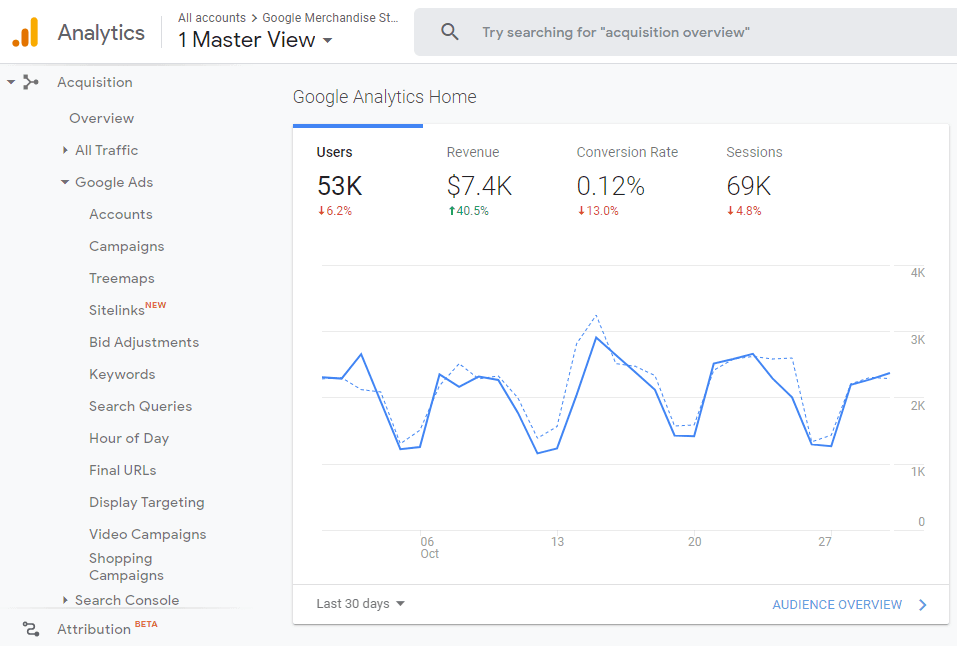
What does the graph tell us about this campaign?
- First, this ad’s performance has a cyclical pattern. This likely means that it gets fewer clicks on a weekend.
- Secondly, the pattern generally remained stable over the month.
- The worst-performing statistic is conversion rate, which is down by 13%. This may mean that the landing page needs to be improved to encourage visitors to convert.
➡️ Adjust and refine as you go
Once the data—and, hopefully, lots of new patients—have started to roll in, you can adjust your campaign accordingly and make informed decisions about your ad strategy.
The great thing about having access to your results is that you can pivot as you go and take steps toward running a killer campaign that produces excellent results.
Advanced PPC Tactics for Doctors
Optimize for voice search
More and more people are using smart devices to search Google. So, optimizing your PPC campaigns for voice search is a good idea.
Here are some ways to optimize your campaigns for voice search:
✔️Incorporate long-tail keywords: Incorporate long-tail keywords that mimic natural speech patterns into your PPC campaigns. As voice searches tend to be more conversational, these keywords can help your ads appear in relevant voice searches.
✔️Question-based queries: Optimize your ad copy for question-based queries commonly used in voice searches. Questions like "What are the symptoms of [condition]?" or "Where can I find a [specialty] doctor near me?" can guide your keyword strategy.
✔️Consider your local SEO: Since many voice searches are local, ensure your online presence (website, Google My Business listing) is optimized for local SEO. This can increase your visibility in "near me" voice searches.
Leverage Smart Campaigns
Smart Campaigns on Google Ads are automated ad campaigns that use machine learning to simplify ad management.
Smart Campaigns automatically manage your ads by choosing where and when they appear, targeting the right audience based on your business's product or service, and using machine learning to optimize results based on your desired goal.
To implement Smart Campaigns, you must set your campaign goal, define your practice or medical specialism, select your target audience, and set your budget.
For example, a campaign goal could be to get more customer calls or visits to your practice.
Google's machine learning then automatically takes care of the ad creation, placement, and optimization.
Consider implementing cross-channel marketing
Integrate PPC with other digital marketing channels like social media, email marketing, and SEO.
By analyzing data from PPC campaigns, such as high-performing keywords and ad copy, doctors can better refine their content marketing strategies to address their target audience's interests and needs.
On the other hand, insights gained from content engagement on social media or SEO performance can help optimize PPC campaigns for better relevance and conversion rates.
This integrated approach ensures a consistent and reinforced brand message across all digital platforms, enhancing visibility, patient engagement, and the effectiveness of overall marketing efforts.
Level up your use of negative keywords
As mentioned earlier, negative keywords improve the chances of attracting the right patients, making your advertising more cost-effective and efficient.
Here’s how to use negative keywords to greater effect:
✔️Analyze search query reports regularly: Regularly review reports to identify irrelevant search terms that trigger your ads. This will help you find new negative keywords to add, ensuring your ads are more targeted.
✔️Use broad, phrase, and exact match negatives: Understand and utilize broad, phrase, and exact match negative keywords to fine-tune how your ads are excluded from certain searches.
✔️Segment negative keywords: Organize your negative keywords into lists that can be applied to specific campaigns or ad groups. This segmentation allows for more tailored exclusions and improves the relevance of your ads.
✔️Leverage competitor insights: Consider adding competitor names or unrelated services as negative keywords if you find your ads appearing in searches for them. This prevents your budget from being spent on users looking for services you don’t offer or competitor information.
How PPC.io Can Boost Your Medical Practice
For busy medical professionals, mastering online advertising is challenging, but PPC.io is here to help.
By understanding the unique demands of medical advertising, we avoid costly mistakes that could impact your budget and reputation.
Not only does our approach focus on reaching the right patients with carefully crafted messages, but our team is also adept at:
✅ Conducting in-depth keyword research
✅ Writing effective ad copy
✅ Implementing strategic bidding for visible results
By partnering with us, you can concentrate on your patients while we expertly manage your online presence.
Interested in enhancing your practice's visibility and patient reach? Connect with us and learn how we can help your medical practice thrive.
